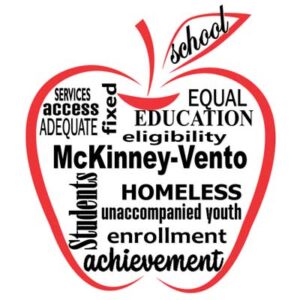McKinney-Vento Program
Program Overview
McKinney-Vento Program
WHCS offers services and support for children, youth, and their families who experience homelessness.
The McKinney-Vento Program does not provide housing or hotel vouchers. Our team can work with families to connect them with community organizations that provide shelter and housing support. WHCS will connect with the local Tribal programs where the student is tribally enrolled.
The trauma of homelessness, severe poverty, and high mobility combine to wreak havoc on the academic progress of children and youth in school. According to a report issued by the U.S. Department of Education (2024–2025), more and more students continue to struggle with the burden of finding a stable place to live, and the number of homeless students in America has topped 1 million for the first time as a result of the prolonged economic recession. The largest and most important safety net for homeless children and youth is the public school system, which provides both basic services as well as the education that is necessary to avoid poverty as adults.

High Rates of Insecurity:
Studies have shown that a large percentage of Native American students in New Mexico experience food and housing insecurity.
www.walatowahcs.org
American Indian students
food and housing insecurity
Racial Disparities:
Native American and Black students are at a greater disadvantage than other students in New Mexico, with 70% of Native American students experiencing food insecurity and 69% experiencing housing insecurity.
According to McKinney-Vento Homeless Assistance Act, homeless children and youth means “individuals who lack a fixed, regular, and adequate nighttime residence” and includes:
- Children and youth who are sharing the housing of other persons due to loss of housing or economic hardship, living in emergency or transitional shelters, abandoned in hospitals, or awaiting foster care placement
- Children and youth who have a primary nighttime residence that is a public or private place not designed for or ordinarily used as a regular sleeping accommodation for human beings
- Children and youth who are living in cars, parks, public spaces, abandoned buildings, substandard housing, bus or train stations, or similar settings
- Migratory children who qualify as homeless due to living circumstances described
Homelessness among families has increased considerably in recent years and is most often due to unexpected financial setbacks that create a situation where the family can no longer pay for their housing. Research indicates that the enriching experiences of a high-quality education can be especially beneficial for homeless children because they provide stability and daily routines that may otherwise be scarce in these children’s lives.
Title I Homeless Project shall provide the means, motivation, and encouragement needed for homeless students to reach their potentials as productive members of society in an educational environment that treats all students with dignity and respect.
What is Title I?
WHCS Title I is a federally funded program designed to meet the needs of students primarily in the areas of language arts, math, science, and higher thinking skills. Homeless children are eligible for these services regardless of where they attend school.
WHCS Title I McKinney-Vento Homeless Program offers many services to homeless children and their families, including:
- Enrollment assistance
- Transportation to school of origin
- School supplies
- School uniforms
- After-school tutoring programs
- Student Support Services: reading/math programs
- Referrals for Social Services (Tribal/State Agencies)
- Referrals to Health Care for the Homeless (JHHS)
Community Collaboration: It takes a whole community to provide the support homeless students need to succeed in school.
Pueblo of Jemez Tribal Programs & Pueblo of Jemez Health and Human Services
- Health Information Management (HIM)
- Information Technology (IT)
- Patient Registration
- Purchased Referred Care (PRC)
- Clinical Services
- Behavioral Health Program
- Dental Clinic
- Medical Clinic
- Optometry Clinic
- Patient Forms
- Pharmacy
- Screening, Brief Intervention, and Referral to Treatment (SBIRT)
- Social Work and Benefits/Home Health Program (SWB)
- Community Services
- Community Wellness Program
- Jemez Vocational Rehabilitation Program
- Public Health Programs
- Senior Center
- Social Services Programs
- Transportation Programs
- Tribal Enrollment
Pueblo of Jemez Tribal Education Program:
- Higher Education Resources
- FAFSA
- Sample Form Letters
- Updated Federal FAFSA Guidance – July 19, 2024
- Higher Education
- Tips for Helping Homeless Youth Succeed in College
- NM Higher Education Department Scholarships
- SHC Scholarship Program
- Best Colleges: Homeless Student Resource Guide
Sandoval Community Homeless Services
Jemez Springs Baptist Church
Food Assistance (SNAP), Medical Assistance (Medicaid), Cash Assistance (TANF), and Energy Assistance (LIHEAP):
yes.state.nm.us
First Nations Community HealthSource (FNCH) Homeless Outreach Program (HOP)
New Mexico Coalition to End Homelessness
WHCS McKinney-Vento Program Key Contacts
| Contact Name | Phone | |
|---|---|---|
| Francine Garcia – WHCS McKinney Vento Coordinator | (505) 527-3392 | fgarcia@walatowahcs.org |
| Dr. A. Wilkinson – WHCS Executive Director | (505) 527-3392 | awilkinson@walatowahcs.org |
| Henrietta Gachupin – Director, Pueblo of Jemez Social Services | (575) 834-7413 | henrietta.gachupin@jemezpueblo.us |
| Kevin Shendo – Pueblo of Jemez Education | (575) 834-9102 | shendo@jemezpueblo.org |
Forms & Downloads
Students Experiencing Homelessness or Unaccompanied Youth Dispute Resolution Form
